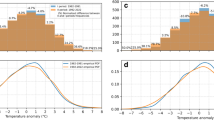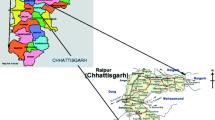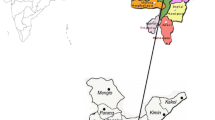Abstract
Climatic characteristics are affected by various systematic and occasional impacts: besides the changes in the observing system (locations of the stations of the meteorological network, instruments, observing procedures), the possible local-scale and global natural and antropogenic impacts on climatic conditions should be taken into account. Apart from the predictability problems, the phenomenological analysis of the climatic variability and the determination of past persistent climatic anomalies are significant problems, among other aspects, as evidence of the possible anomalous behavior of climate or for climate impact studies. In this paper, a special technique for the identification of such “shifts” in the observational series is presented. The existence of these significant shorter or longer term changes in the mean characteristics for the properly selected adjoining periods of time is the necessary condition for the formation of any more or less unidirectional climatic trends. Actually, the window technique is based on a complete set of orthogonal functions. The sensitivity of the proposed model on its main parameters is also investigated. This method is applied for hemispheric and Hungarian data series of the mean annual surface temperature.
Similar content being viewed by others
References
Agee EM (1982) A diagnosis of twentieth century temperature records at West Lafayette, Indiana. Climatic Change 4:399–418
Angell JK (1988) Variations and trends in tropospheric and stratospheric global temperatures 1958–87. J Climate 1:1296–1313
Callendar GS (1961) Temperature fluctuations and trends over the earth. Quart J Roy Meteor Soc 87:1–2
Dixon KW, Shulman MD (1984) A statistical evaluation of the abilities of climatic averages. J Climate Appl Meteor23:1542–1552
Epstein ES (1982) Detecting climate change. J Appl Meteor 21:1172–1181
Gruza GV, Kachurina LR, Khvostova RN (1987) Choice of a period for estimating the multiyear statistics of the mean monthly surface temperature (in Russian). Meteor Gidrol No 11:66–74
Hansen J, Lebedeff S (1987) Global trends of measured surface air temperature. J Geophys Res 92:13345–13372
Hansen J, Lebedeff S (1988) Global surface air temperatures: update through 1987. Geophys Res Lett 15:323–326
Jones PD, Raper SCB, Bradley RS, Diaz HF, Kelley PM, Wigley TML (1986) Northern Hemisphere surface air temperature variations: 1851–1984. J Climate Appl Meteor 25:161–179
Jones PD, Kelly PM (1983) The spatial and temporal characteristics of Northern Hemisphere surface air temperature variations. J Climatol 3:243–252
Jones PD, Wigley TML, Wright PB (1990) Global and hemispheric annual temperature variations between 1881 and 1988. NDP-022/R1, Carbon Dioxide Information Analysis Center, Oak Ridge National Laboratory, Oak Ridge, Tennessee, USA
Karl TR, Riebsame WE (1984) Identification of 10- to 20-year temperature and precipitation fluctuations in the contiguous United States. J Appl Meteor 23:950–966
Karl TR, Quayle RG (1988) Climate change in fact and in theory: are we collecting facts? Climatic Change 13:5–17
Kim JW, Chang JT, Baker NL, Wilks DS, Gates WL (1984) The statistical problem of climate conversion: determination of the relationship between local and large-scale climate. Mon Wea Rev 112:2069–2077
Knox JL, Higuchi K, Shabbar A, Sargent NE (1988) Secular variation of Northern Hemisphere 50 kPa geopotential height. J Climate 1:500–510
Kolmogorov AN, Fomin SzV (1960) Elements of theory of functions and functional analysis (in Russian). Nauka, Moscow
Madden RA, Ramanathan V (1980) Detecting climate change due to increasing carbon dioxide. Science 209:763–768
Riesz F, Sz. Nagy B (1953) Legons d'analyse functionelle. 2. edition. Hungarian Academy of Sciences, Budapest
Solow AR (1987) Testing for climatic change: an application of the two-phase regression model. J Climate Appl Meteor 26:1401–1405
Vinnikov KY, Groisman PY (1981) The empirical analysis of CO2 influence on modern changes of the mean annual Northern Hemisphere surface air temperature. Meteor Gidrol 11:30–43
Vinnikov KY, Groisman PY, Lugina KM, Golubev AA (1987) Variatons in Northern Hemisphere mean surface air temperature over 1841–1985. Meteor Gidrol 17:45–55
Wigley TML, Jones PD (1982) Signal-to-noise ratios for surface air temperature and detection of CO2-induced climatic change. In: Moses H, MacCracken MC (eds) Proceedings of the Workshop on First Detection of Carbon Dioxide Effects. DOE Report CONF-8106214, pp 143–158
Wigley TML, Jones PD, Kelly PM (1986) Empirical climate studies. In: The greenhouse effect, climatic change, and ecosystems. SCOPE 29, pp 271–322
Williams J, van Loon H (1976) The connection between trends of mean temperature and circulation at the surface. Part III: Spring and Autumn. Mon Wea Rev 104:1591–1596
Author information
Authors and Affiliations
Additional information
Contribution to Clima Locarno — Past and Present Climate Dynamics; Conference September 1990, Swiss Academy of Sciences — National Climate Program
Rights and permissions
About this article
Cite this article
Szentimrey, T., Faragó, T. & Szalai, S. Window technique for climate trend analysis. Climate Dynamics 6, 127–134 (1992). https://doi.org/10.1007/BF00193524
Received:
Accepted:
Issue Date:
DOI: https://doi.org/10.1007/BF00193524




